2013 Hyundai Sonata Hybrid Hev battery
[x] Cancel search: Hev batteryPage 247 of 425
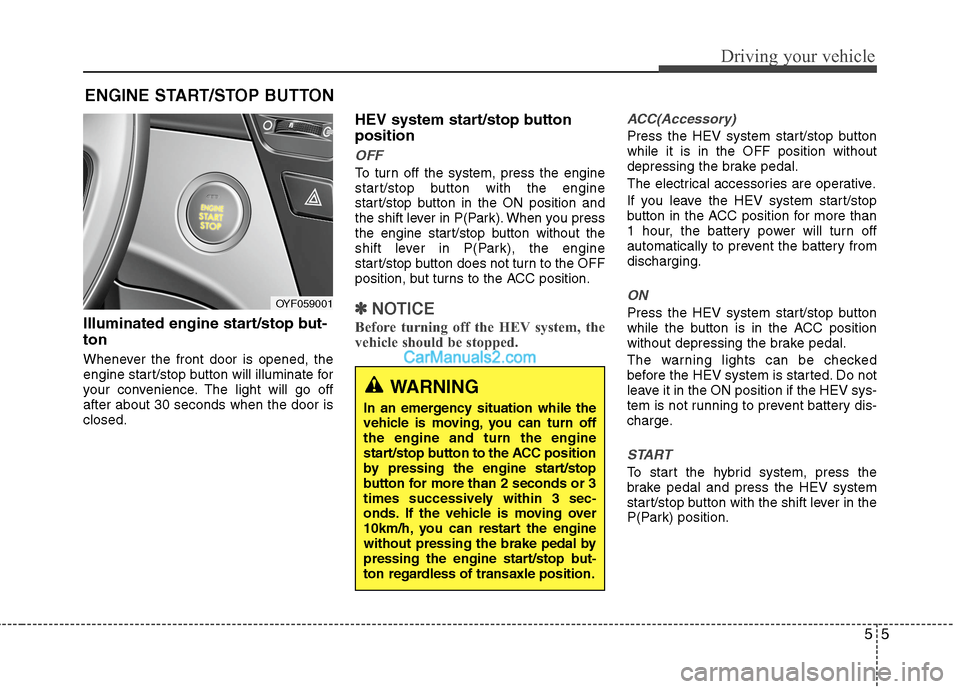
55
Driving your vehicle
Illuminated engine start/stop but-
ton
Whenever the front door is opened, the
engine start/stop button will illuminate for
your convenience. The light will go off
after about 30 seconds when the door is
closed.
HEV system start/stop button
position
OFF
To turn off the system, press the engine
start/stop button with the engine
start/stop button in the ON position and
the shift lever in P(Park). When you press
the engine start/stop button without the
shift lever in P(Park), the engine
start/stop button does not turn to the OFF
position, but turns to the ACC position.
✽ ✽
NOTICE
Before turning off the HEV system, the
vehicle should be stopped.
ACC(Accessory)
Press the HEV system start/stop button
while it is in the OFF position without
depressing the brake pedal.
The electrical accessories are operative.
If you leave the HEV system start/stop
button in the ACC position for more than
1 hour, the battery power will turn off
automatically to prevent the battery from
discharging.
ON
Press the HEV system start/stop button
while the button is in the ACC position
without depressing the brake pedal.
The warning lights can be checked
before the HEV system is started. Do not
leave it in the ON position if the HEV sys-
tem is not running to prevent battery dis-
charge.
START
To start the hybrid system, press the
brake pedal and press the HEV system
start/stop button with the shift lever in the
P(Park) position.
ENGINE START/STOP BUTTON
OYF059001
WARNING
In an emergency situation while the
vehicle is moving, you can turn off
the engine and turn the engine
start/stop button to the ACC position
by pressing the engine start/stop
button for more than 2 seconds or 3
times successively within 3 sec-
onds. If the vehicle is moving over
10km/h, you can restart the engine
without pressing the brake pedal by
pressing the engine start/stop but-
ton regardless of transaxle position.
Page 248 of 425
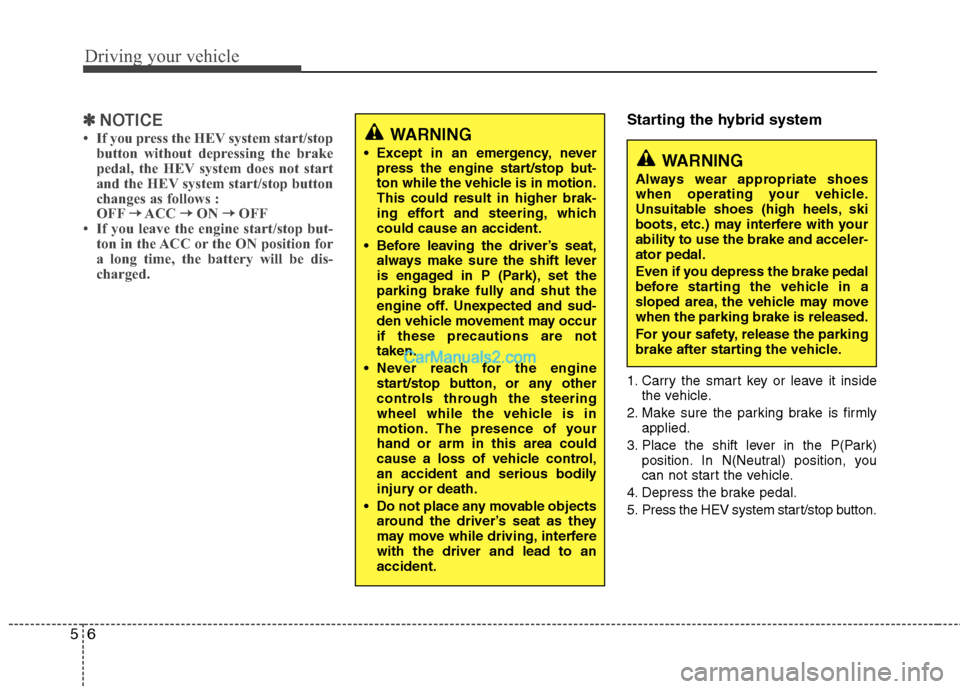
Driving your vehicle
6 5
✽
✽
NOTICE
• If you press the HEV system start/stop
button without depressing the brake
pedal, the HEV system does not start
and the HEV system start/stop button
changes as follows :
OFF→ →
ACC → →
ON → →
OFF
• If you leave the engine start/stop but-
ton in the ACC or the ON position for
a long time, the battery will be dis-
charged.
Starting the hybrid system
1. Carry the smart key or leave it inside
the vehicle.
2. Make sure the parking brake is firmly
applied.
3. Place the shift lever in the P(Park)
position. In N(Neutral) position, you
can not start the vehicle.
4. Depress the brake pedal.
5. Press the HEV system start/stop button.
WARNING
Except in an emergency, never
press the engine start/stop but-
ton while the vehicle is in motion.
This could result in higher brak-
ing effort and steering, which
could cause an accident.
Before leaving the driver’s seat,
always make sure the shift lever
is engaged in P (Park), set the
parking brake fully and shut the
engine off. Unexpected and sud-
den vehicle movement may occur
if these precautions are not
taken.
Never reach for the engine
start/stop button, or any other
controls through the steering
wheel while the vehicle is in
motion. The presence of your
hand or arm in this area could
cause a loss of vehicle control,
an accident and serious bodily
injury or death.
Do not place any movable objects
around the driver’s seat as they
may move while driving, interfere
with the driver and lead to an
accident.WARNING
Always wear appropriate shoes
when operating your vehicle.
Unsuitable shoes (high heels, ski
boots, etc.) may interfere with your
ability to use the brake and acceler-
ator pedal.
Even if you depress the brake pedal
before starting the vehicle in a
sloped area, the vehicle may move
when the parking brake is released.
For your safety, release the parking
brake after starting the vehicle.
Page 250 of 425
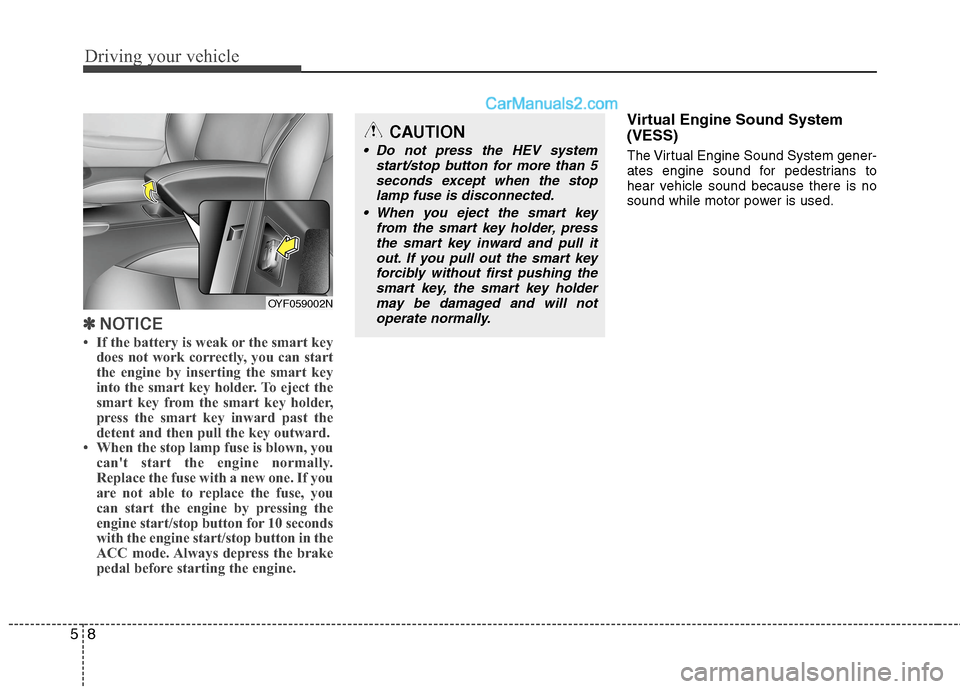
Driving your vehicle
8 5
✽
✽
NOTICE
• If the battery is weak or the smart key
does not work correctly, you can start
the engine by inserting the smart key
into the smart key holder. To eject the
smart key from the smart key holder,
press the smart key inward past the
detent and then pull the key outward.
• When the stop lamp fuse is blown, you
can't start the engine normally.
Replace the fuse with a new one. If you
are not able to replace the fuse, you
can start the engine by pressing the
engine start/stop button for 10 seconds
with the engine start/stop button in the
ACC mode. Always depress the brake
pedal before starting the engine.
Virtual Engine Sound System
(VESS)
The Virtual Engine Sound System gener-
ates engine sound for pedestrians to
hear vehicle sound because there is no
sound while motor power is used.
CAUTION
Do not press the HEV system
start/stop button for more than 5
seconds except when the stop
lamp fuse is disconnected.
When you eject the smart key
from the smart key holder, press
the smart key inward and pull it
out. If you pull out the smart key
forcibly without first pushing the
smart key, the smart key holder
may be damaged and will not
operate normally.
OYF059002N
Page 278 of 425
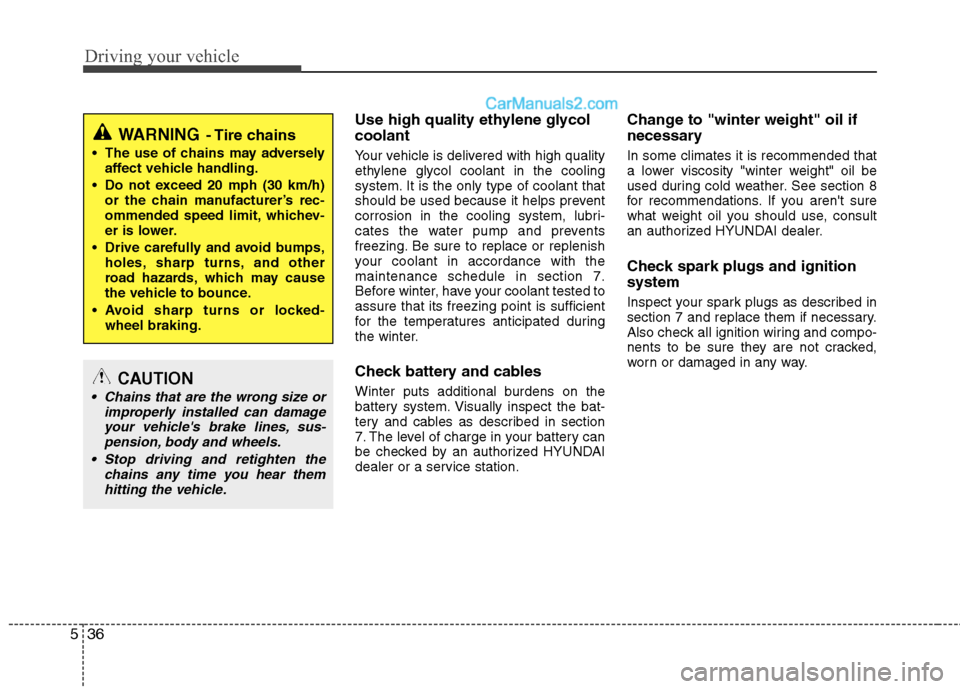
Driving your vehicle
36 5
Use high quality ethylene glycol
coolant
Your vehicle is delivered with high quality
ethylene glycol coolant in the cooling
system. It is the only type of coolant that
should be used because it helps prevent
corrosion in the cooling system, lubri-
cates the water pump and prevents
freezing. Be sure to replace or replenish
your coolant in accordance with the
maintenance schedule in section 7.
Before winter, have your coolant tested to
assure that its freezing point is sufficient
for the temperatures anticipated during
the winter.
Check battery and cables
Winter puts additional burdens on the
battery system. Visually inspect the bat-
tery and cables as described in section
7. The level of charge in your battery can
be checked by an authorized HYUNDAI
dealer or a service station.
Change to "winter weight" oil if
necessary
In some climates it is recommended that
a lower viscosity "winter weight" oil be
used during cold weather. See section 8
for recommendations. If you aren't sure
what weight oil you should use, consult
an authorized HYUNDAI dealer.
Check spark plugs and ignition
system
Inspect your spark plugs as described in
section 7 and replace them if necessary.
Also check all ignition wiring and compo-
nents to be sure they are not cracked,
worn or damaged in any way.
WARNING- Tire chains
The use of chains may adversely
affect vehicle handling.
Do not exceed 20 mph (30 km/h)
or the chain manufacturer’s rec-
ommended speed limit, whichev-
er is lower.
Drive carefully and avoid bumps,
holes, sharp turns, and other
road hazards, which may cause
the vehicle to bounce.
Avoid sharp turns or locked-
wheel braking.
CAUTION
Chains that are the wrong size or
improperly installed can damage
your vehicle's brake lines, sus-
pension, body and wheels.
Stop driving and retighten the
chains any time you hear them
hitting the vehicle.
Page 404 of 425
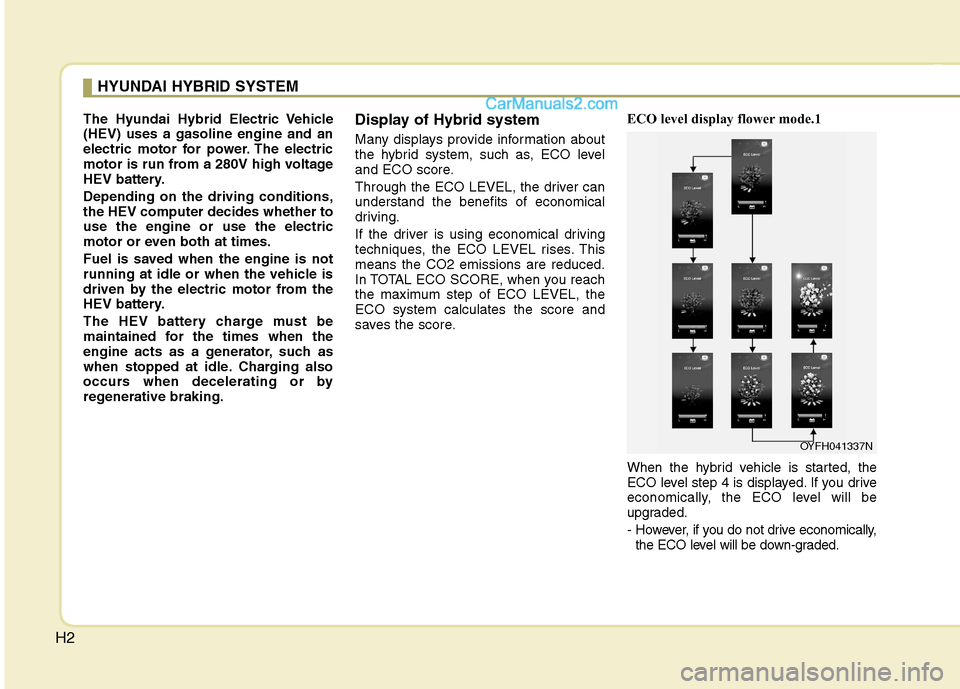
H2
The Hyundai Hybrid Electric Vehicle
(HEV) uses a gasoline engine and an
electric motor for power. The electric
motor is run from a 280V high voltage
HEV battery.
Depending on the driving conditions,
the HEV computer decides whether to
use the engine or use the electric
motor or even both at times.
Fuel is saved when the engine is not
running at idle or when the vehicle is
driven by the electric motor from the
HEV battery.
The HEV battery charge must be
maintained for the times when the
engine acts as a generator, such as
when stopped at idle. Charging also
occurs when decelerating or by
regenerative braking.Display of Hybrid system
Many displays provide information about
the hybrid system, such as, ECO level
and ECO score.
Through the ECO LEVEL, the driver can
understand the benefits of economical
driving.
If the driver is using economical driving
techniques, the ECO LEVEL rises. This
means the CO2 emissions are reduced.
In TOTAL ECO SCORE, when you reach
the maximum step of ECO LEVEL, the
ECO system calculates the score and
saves the score.ECO level display flower mode.1
When the hybrid vehicle is started, the
ECO level step 4 is displayed. If you drive
economically, the ECO level will be
upgraded.
- However, if you do not drive economically,
the ECO level will be down-graded.
HYUNDAI HYBRID SYSTEM
OYFH041337N
Page 406 of 425
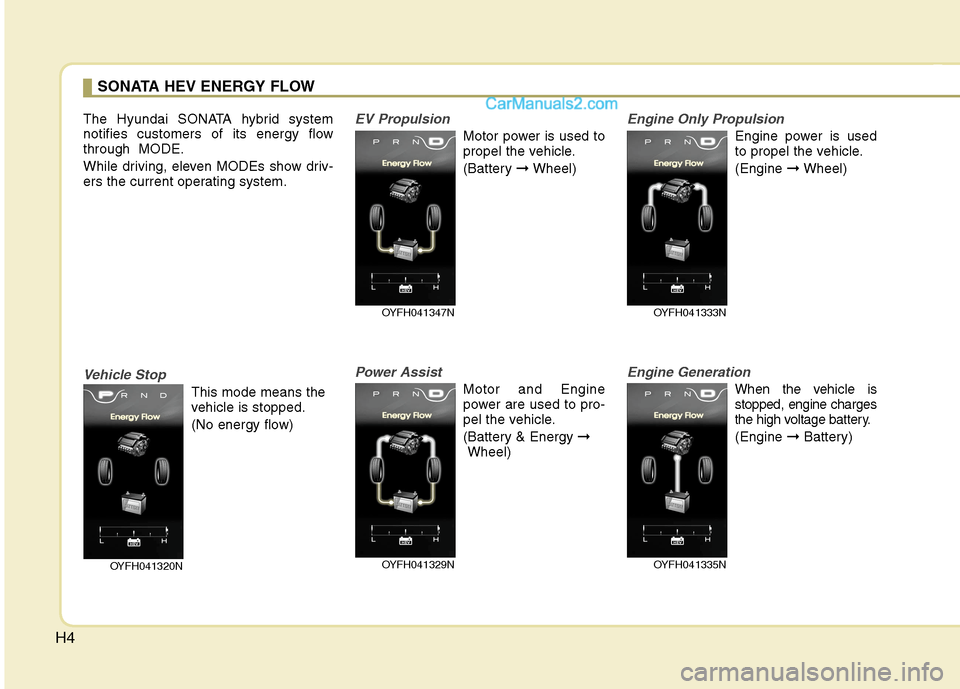
H4
The Hyundai SONATA hybrid system
notifies customers of its energy flow
through MODE.
While driving, eleven MODEs show driv-
ers the current operating system.
Vehicle Stop
This mode means the
vehicle is stopped.
(No energy flow)
EV Propulsion
Motor power is used to
propel the vehicle.
(Battery ➞Wheel)
Power Assist
Motor and Engine
power are used to pro-
pel the vehicle.
(Battery & Energy ➞
Wheel)
Engine Only Propulsion
Engine power is used
to propel the vehicle.
(Engine ➞Wheel)
Engine Generation
When the vehicle is
stopped, engine charges
the high voltage battery.
(Engine ➞Battery)
SONATA HEV ENERGY FLOW
OYFH041320N
OYFH041347N
OYFH041329N
OYFH041333N
OYFH041335N
Page 410 of 425
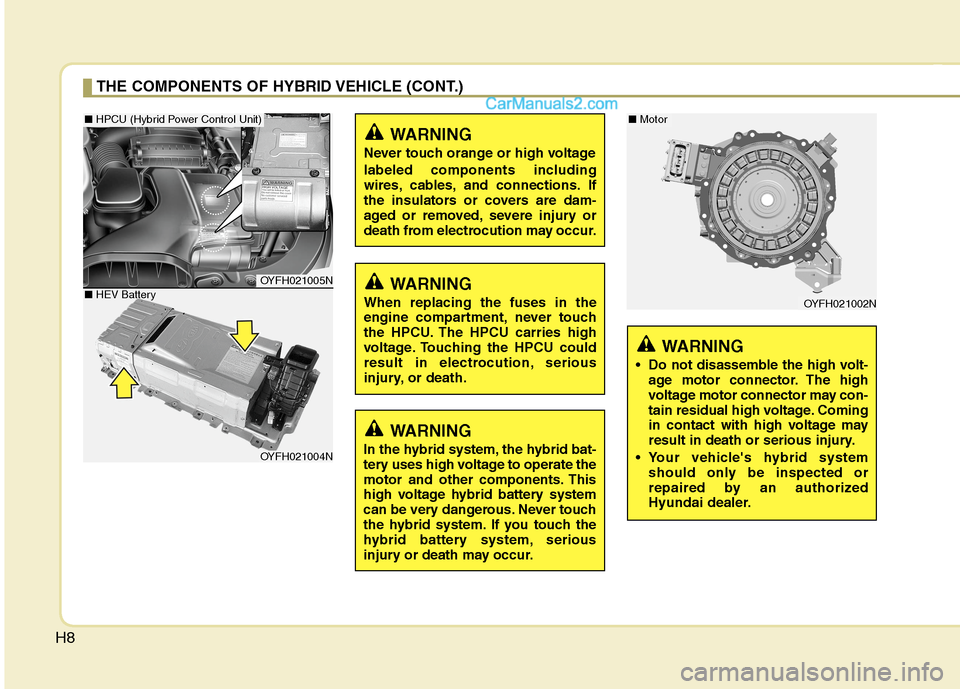
H8
THE COMPONENTS OF HYBRID VEHICLE (CONT.)
WARNING
In the hybrid system, the hybrid bat-
tery uses high voltage to operate the
motor and other components. This
high voltage hybrid battery system
can be very dangerous. Never touch
the hybrid system. If you touch the
hybrid battery system, serious
injury or death may occur.
WARNING
Never touch orange or high voltage
labeled components including
wires, cables, and connections. If
the insulators or covers are dam-
aged or removed, severe injury or
death from electrocution may occur.
WARNING
When replacing the fuses in the
engine compartment, never touch
the HPCU. The HPCU carries high
voltage. Touching the HPCU could
result in electrocution, serious
injury, or death.
OYFH021005N
OYFH021004N
OYFH021002N
WARNING
• Do not disassemble the high volt-
age motor connector. The high
voltage motor connector may con-
tain residual high voltage. Coming
in contact with high voltage may
result in death or serious injury.
Your vehicle's hybrid system
should only be inspected or
repaired by an authorized
Hyundai dealer.
■ HPCU (Hybrid Power Control Unit)■ Motor
■ HEV Battery
Page 421 of 425

I5
Index
Multi fuse ··································································7-53
Gauge
Engine temperature gauge·········································4-42
Fuel gauge ·································································4-43
Glass antenna ·······························································4-113
Glove box·····································································4-107
Hazard warning flasher··················································4-70
Hazardous driving conditions ········································5-30
Headlight bulb replacement ···········································7-61
Headrest ··································································3-7, 3-11
High voltage battery ······················································7-78
Highway driving ····························································5-33
Hill-start assist control (HAC)·······································5-22
Homelink mirror, see the Electric chromic mirror (ECM)
with HomeLink system ·············································4-31
Hood···············································································4-21
Horn ···············································································4-30
How to use this manual ···················································1-2
Hybrid
HMC Hybrid system····················································H2
Sonata hev energy flow ······································H4, 4-45
State of charge (SOC) ··················································H3
The air intake of hybrid battery ·································H12
The componets of hybrid vehicle ································H7The ECO GUIDE gauge ···········································4-43
The ECO level····················································H2, 4-47
The EV MODE ·························································4-53
The READY indicator···············································4-41
The service indicator ·················································4-53
Hybrid electric vehicle···················································4-45
Immobilizer system ·························································4-7
Indicator symbols on the instrument cluster ···················1-7
Indicators and warnings ·················································4-53
Inside rearview mirror ···················································4-31
Instrument cluster ··························································4-40
Blue drive mode ························································4-44
Engine temperature gauge·········································4-42
Fuel gauge ·································································4-43
Hybrid electric vehicle ··············································4-45
Instrument panel illumination ···································4-41
Odometer ···································································4-41
Speedometer ······························································4-42
Trip computer ····························································4-44
Vehicle setting ···························································4-51
Warning and indicators ·············································4-53
Instrument panel fuse·····················································7-51
Instrument panel illumination········································4-41
Instrument panel overview ··············································2-3
Interior care····································································7-73
Interior features····························································4-108
G
I
H